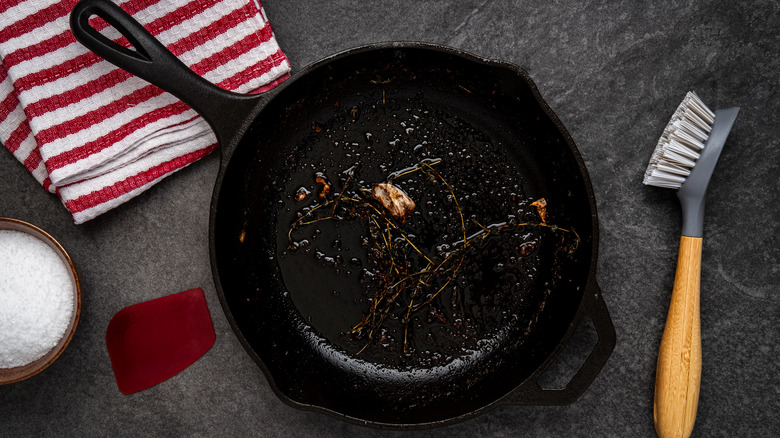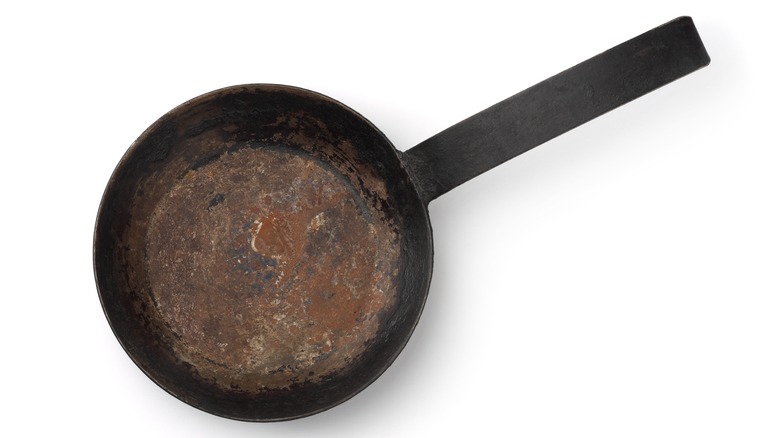How To Care For Your Cast Iron Pan
A cast-iron pan is a kitchen must-have for any avid cook. They can withstand high temperatures, making them safe to use both on the stovetop and in the oven. Because of their excellent heat retention, cast iron pans are the ideal tool for searing meat at high temperatures to achieve that perfect browned crust. When cast iron is well-seasoned, it develops a non-stick surface that can cook anything from eggs to vegetables to delicate fish fillets. According to Michigan State University, a cast iron pan will last for generations as long as it's properly cared for.
Cast iron has a bad reputation, however, for being tricky to take care of. While many people are understandably intimidated by caring for cast iron cookware, it's not as complicated as it seems. Read on and we'll break down everything you need to know about cleaning and maintaining your cast iron pan to ensure it lasts for years to come.
Wash it by hand
When you first bring home your cast iron pan, it's important to wash it, according to Kitchn. This will ensure that any factory residue or dust and dirt is washed away. Additionally, while cast iron is known for being able to handle high heat, it should never be placed in the dishwasher. For the best results, always wash cast iron cookware by hand to avoid wearing away at the seasoning. While some purists may caution against using sponges or dish brushes on cast iron, Cooks Illustrated assures readers that it's totally fine to use a "nonmetal brush or nonabrasive scrub pad."
Use minimal soap
While many people think using soap on a cast iron pan is a major no-no, that's actually somewhat of a myth. While it's true that you should never use harsh cleaning agents on cast iron, a simple cleaning solution like dish soap won't negatively affect the pan's surface. According to Lodge, one of the biggest cast iron manufacturers on the market, it's totally fine to use a small amount of gentle dish soap when washing your cast iron cookware.
Season the pan with oil
Once the pan has been cleaned and dried, pour a teaspoon of cooking oil onto its surface and make sure every inch is coated. Southern Living recommends placing the pan upside down in an oven preheated to 375 degrees and allowing it to cook for one hour. The oil seeps into the tiny holes in the cast iron's surface, creating a smooth, uniform layer. This helps to season the cast iron and maintain its non-stick surface. On a more everyday basis, simply rub oil on the pan with a paper towel. Oiling your pan regularly ensures that you can use less oil when cooking.
Choose the right oil
When it comes to seasoning your cast iron pan, it's important to choose the right oil. According to Uno Casa, there are pros and cons to different common cooking oils when it comes to seasoning cast iron. They recommend top picks like flaxseed and grapeseed oil as the ideal options, as well as affordable versatile kitchen mainstays like canola oil and vegetable oil. The one oil you shouldn't use is olive oil because it has a low smoke point of 375 degrees and isn't compatible with high-temperature cooking.
Choose a pre-seasoned option
Those who want to skip out on the initial seasoning process can purchase pre-seasoned cast iron cookware from a number of different retailers. In fact, the majority of cast iron on the market today comes pre-seasoned, according to Serious Eats. When using a new pre-seasoned cast iron pan, you simply need to wash it before use and don't need to undertake a major seasoning process, though some seasoning will still benefit the flavor and the pan's non-stick abilities.
Simmer water to remove stuck-on food
Even with well-seasoned cast iron, food particles will inevitably become stuck to the pan's surface from time to time. If this occurs, fill the pan with a couple of inches of water and bring it to boil on the stovetop, suggests Lodge. Allow the water to simmer for between three and five minutes, and you'll notice those stuck-on food particles start to soften. After allowing the water to cool slightly, use a cast iron scraper to remove any remaining residue.
Use a salt and oil mixture
If the water simmering trick doesn't get the job done, there are still some options at your disposal for removing caked-on food residue from your cast iron pan. Luckily, the tools you need are already in your kitchen. Simply add a couple of tablespoons of oil and a couple of tablespoons of kosher salt to the pan and use a paper towel to scrub at the affected areas until the burnt particles loosen, explains Kitchn.
Make sure it's dry
It's important to dry your cast iron cookware thoroughly after each wash because moisture build-up can lead to the development of rust. Lodge recommends drying cast iron with a lint-free microfiber cloth for the best results. Serious Eats suggests another trick for ensuring the pan is dry, which is to place it on the stove on high. Doing so will hasten the evaporation process, ensuring your cast iron pan is super dry. When storing cast iron, place a paper towel on the surface to soak up any remaining moisture. This trick also protects the pan if it's being stacked with other cookware for storage.
Strip the pan to remove rust
If you find a great deal on a vintage cast iron pan that's coated in rust, have no fear; it's totally possible to bring it back to its former glory. According to Bon Appétit, a soak in a mixture of white vinegar and water will get rid of rust by eating away at the material's surface. Submerge the skillet completely in the vinegar solution for an hour before checking to see if the rust easily peels away. While this process will remove rust, it will also wear away at the pan's seasoning, so you'll have to completely reseason the pan once the rust is gone.









